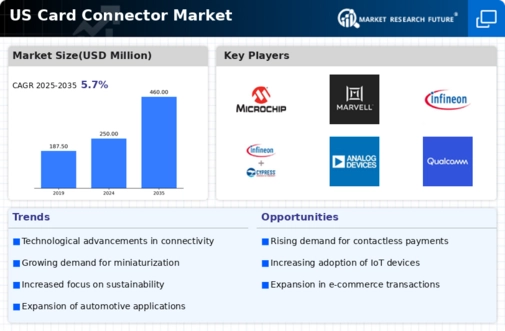Growth in IoT Devices
The proliferation of Internet of Things (IoT) devices is a significant driver for the card connector market. As more devices become interconnected, the need for efficient data transfer and connectivity solutions intensifies. In 2025, the IoT market in the US is projected to reach $1 trillion, with a substantial portion of this growth attributed to smart home devices, industrial automation, and healthcare applications. The card connector market stands to gain from this trend, as these connectors are vital for ensuring reliable communication between IoT devices. Manufacturers are likely to focus on developing connectors that can withstand various environmental conditions while maintaining high performance, thereby enhancing the overall functionality of IoT ecosystems.
Emergence of 5G Technology
The rollout of 5G technology is poised to transform various industries, including telecommunications and consumer electronics, thereby impacting the card connector market. With the increased demand for high-speed data transfer and connectivity, the need for advanced card connectors that can support 5G applications becomes critical. In 2025, the 5G infrastructure market in the US is projected to reach $50 billion, driving the demand for components that facilitate this technology. The card connector market is likely to benefit from this trend as manufacturers develop connectors that can handle higher frequencies and data rates, ensuring optimal performance in 5G-enabled devices. This evolution may lead to innovative designs and materials that enhance the reliability and efficiency of card connectors.
Increased Focus on Data Security
As data breaches and cyber threats become more prevalent, the card connector market is witnessing a heightened emphasis on data security. Organizations are increasingly seeking secure card connectors that can protect sensitive information during data transmission. This trend is particularly relevant in sectors such as finance, healthcare, and government, where data integrity is paramount. In 2025, the cybersecurity market in the US is expected to surpass $200 billion, indicating a growing awareness of the importance of secure data handling. Consequently, manufacturers in the card connector market are likely to innovate and develop connectors with enhanced security features, ensuring compliance with industry standards and regulations.
Expansion of Automotive Applications
The automotive sector is increasingly adopting advanced technologies, which significantly impacts the card connector market. As vehicles become more sophisticated, incorporating features such as infotainment systems, advanced driver-assistance systems (ADAS), and electric vehicle (EV) technologies, the demand for reliable card connectors rises. In 2025, the automotive electronics market is expected to exceed $300 billion, with a substantial portion allocated to card connectors. This trend suggests that the card connector market will experience growth as automotive manufacturers seek high-performance connectors to ensure seamless communication between various electronic components. The integration of card connectors in vehicles not only enhances functionality but also contributes to overall vehicle safety and efficiency.
Rising Demand for Consumer Electronics
The card connector market experiences a notable surge in demand driven by the increasing consumption of consumer electronics in the US. With the proliferation of smartphones, tablets, and wearable devices, the need for efficient and reliable card connectors becomes paramount. In 2025, the consumer electronics sector is projected to reach a market value of approximately $400 billion, indicating a robust growth trajectory. This growth directly correlates with the card connector market, as these components are essential for device functionality. As manufacturers strive to enhance user experience, the integration of advanced card connectors is likely to become a focal point in product design. Consequently, the card connector market is poised to benefit from this escalating demand, as companies innovate to meet the evolving needs of consumers.























Leave a Comment